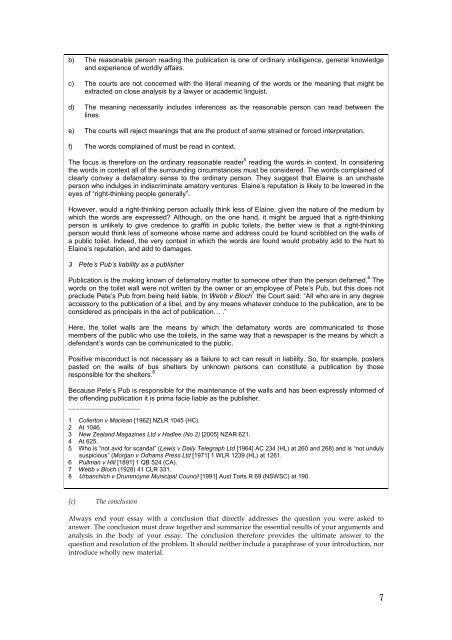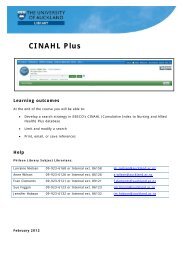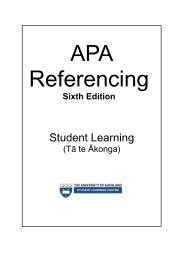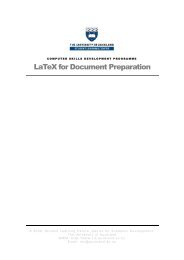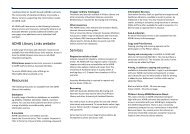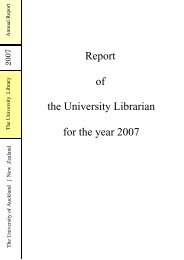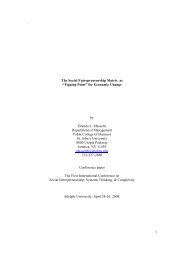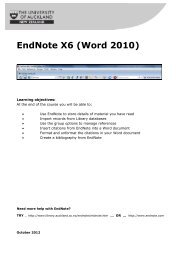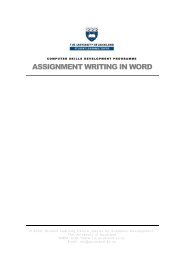Legal Writing Guide - The University of Auckland Library
Legal Writing Guide - The University of Auckland Library
Legal Writing Guide - The University of Auckland Library
You also want an ePaper? Increase the reach of your titles
YUMPU automatically turns print PDFs into web optimized ePapers that Google loves.
) <strong>The</strong> reasonable person reading the publication is one <strong>of</strong> ordinary intelligence, general knowledgeand experience <strong>of</strong> worldly affairs.c) <strong>The</strong> courts are not concerned with the literal meaning <strong>of</strong> the words or the meaning that might beextracted on close analysis by a lawyer or academic linguist.d) <strong>The</strong> meaning necessarily includes inferences as the reasonable person can read between thelines.e) <strong>The</strong> courts will reject meanings that are the product <strong>of</strong> some strained or forced interpretation.f) <strong>The</strong> words complained <strong>of</strong> must be read in context.<strong>The</strong> focus is therefore on the ordinary reasonable reader 5 reading the words in context. In consideringthe words in context all <strong>of</strong> the surrounding circumstances must be considered. <strong>The</strong> words complained <strong>of</strong>clearly convey a defamatory sense to the ordinary person. <strong>The</strong>y suggest that Elaine is an unchasteperson who indulges in indiscriminate amatory ventures. Elaine’s reputation is likely to be lowered in theeyes <strong>of</strong> “right-thinking people generally”.However, would a right-thinking person actually think less <strong>of</strong> Elaine, given the nature <strong>of</strong> the medium bywhich the words are expressed? Although, on the one hand, it might be argued that a right-thinkingperson is unlikely to give credence to graffiti in public toilets, the better view is that a right-thinkingperson would think less <strong>of</strong> someone whose name and address could be found scribbled on the walls <strong>of</strong>a public toilet. Indeed, the very context in which the words are found would probably add to the hurt toElaine’s reputation, and add to damages.3 Pete’s Pub’s liability as a publisherPublication is the making known <strong>of</strong> defamatory matter to someone other than the person defamed. 6 <strong>The</strong>words on the toilet wall were not written by the owner or an employee <strong>of</strong> Pete’s Pub, but this does notpreclude Pete’s Pub from being held liable. In Webb v Bloch 7 the Court said: “All who are in any degreeaccessory to the publication <strong>of</strong> a libel, and by any means whatever conduce to the publication, are to beconsidered as principals in the act <strong>of</strong> publication… .”Here, the toilet walls are the means by which the defamatory words are communicated to thosemembers <strong>of</strong> the public who use the toilets, in the same way that a newspaper is the means by which adefendant’s words can be communicated to the public.Positive misconduct is not necessary as a failure to act can result in liability. So, for example, posterspasted on the walls <strong>of</strong> bus shelters by unknown persons can constitute a publication by thoseresponsible for the shelters. 8Because Pete’s Pub is responsible for the maintenance <strong>of</strong> the walls and has been expressly informed <strong>of</strong>the <strong>of</strong>fending publication it is prima facie liable as the publisher.___________________1 Collerton v Maclean [1962] NZLR 1045 (HC).2 At 1046.3 New Zealand Magazines Ltd v Hadlee (No 2) [2005] NZAR 621.4 At 625.5 Who is “not avid for scandal” (Lewis v Daily Telegraph Ltd [1964] AC 234 (HL) at 260 and 268) and is “not undulysuspicious” (Morgan v Odhams Press Ltd [1971] 1 WLR 1239 (HL) at 1261.6 Pullman v Hill [1891] 1 QB 524 (CA).7 Webb v Bloch (1928) 41 CLR 331.8 Urbanchich v Drummoyne Municipal Council [1991] Aust Torts R 69 (NSWSC) at 190.(c)<strong>The</strong> conclusionAlways end your essay with a conclusion that directly addresses the question you were asked toanswer. <strong>The</strong> conclusion must draw together and summarize the essential results <strong>of</strong> your arguments andanalysis in the body <strong>of</strong> your essay. <strong>The</strong> conclusion therefore provides the ultimate answer to thequestion and resolution <strong>of</strong> the problem. It should neither include a paraphrase <strong>of</strong> your introduction, norintroduce wholly new material.7


